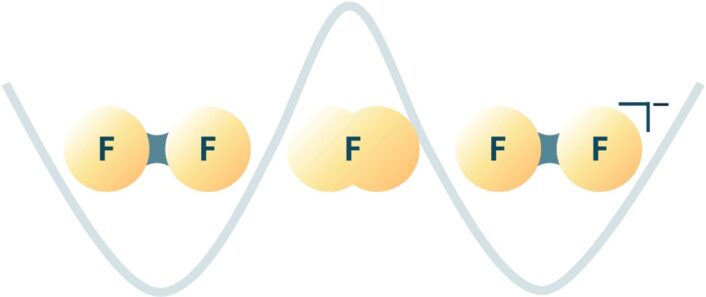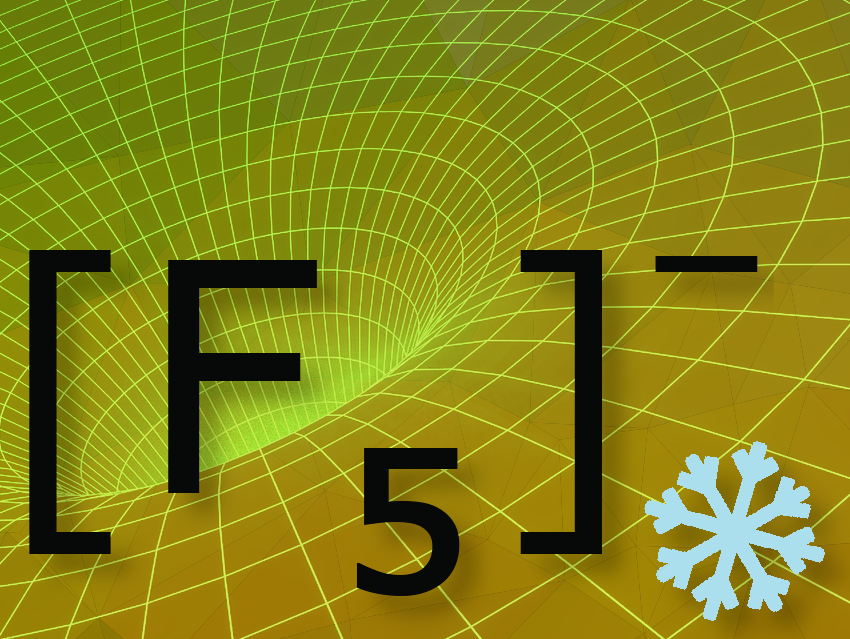Sebastian Hasenstab-Riedel and Carsten Müller, FU Berlin, Germany, and their coauthors have spent over a decade investigating the fascinating behavior of the [F₅]⁻ anion in a cryogenic neon matrix. In this interview, they speak about their results and how their study has advanced the field of molecular chemistry.
What did you do?
Over a decade ago, my team and I managed to capture an unusual molecule, [F₅]⁻, in a neon crystal at −270 °C. This anion—comprising of only five tightly packed, highly charged, and unstable fluorine atoms—should not actually exist, and yet it remained surprisingly stable.
To understand what held this molecule together, researchers from Freie Universität Berlin and the French National Centre for Scientific Research (CNRS) carried out extensive calculations and quantum mechanical simulations. We came across a surprising effect that had up to this point mainly been observed for hydrogen—a very light element—but considered virtually impossible for the relatively heavy fluorine atom: we were able to prove that even fluorine atoms can effectively tunnel—i.e., make a molecule spontaneously transform between two states that are actually separated by a finite energy barrier.

What experimental evidence confirmed that quantum tunneling was occurring in [F₅]⁻ and how?
In the measured IR-spectrum, we observe a splitting of the signal related to the [F₂⋯F⋯F₂]⁻ complex, which, according to our theoretical simulations, can only be explained by a central fluoride ion tunneling with times of 10–360 ps. One important hint was, e.g., that one of the two peaks could be reversibly enhanced by slightly increasing the temperature of the system.
What is new and cool about your research?
The tunneling that was discovered here has already been observed in other molecules of much lighter elements, such as hydrogen and oxygen. Until now, researchers assumed that fluorine atoms were too heavy to tunnel at all, which is why they tended to speak of a “fluoro wall” when it came to tunneling. This paradigm has now been called into question.
In addition, this new study shows that the combination of special bonding conditions in molecules that are trapped in a confined space seems to make it possible for atoms that are heavier than oxygen to tunnel. The findings do not just expand our understanding of chemical bonds in fluorinated compounds, but also provide us with new tools to control molecular reactions in a targeted manner.
Why is this of interest?
Fluorine and fluorinated compounds are commonplace in our everyday lives. Fluorinated groups improve the uptake of medications in the body; fluorinated compounds make cellphone batteries more efficient and allow them to last longer; and fluoride in toothpaste prevents cavities.
At the same time, per- and polyfluoroalkyl substances (PFAS) pose a growing problem for human health and the environment. Extensive research on the science behind the interactions produced by fluorine and its compounds is needed to fully grasp both the positive and negative effects of fluoride in compounds.
What part of your work was the most challenging?
It is very challenging to perform accurate quantum chemical calculations for fluorine and its compounds. The electrons are so densely packed around the atom and in its bonds that their modeling requires very sophisticated and time-consuming simulation methods. That is one reason why this study took more than ten years.
It is great that you and your team persisted despite the challenges. Thank you very much for sharing these insights.
The paper they talked about:
- Experimental observation of quantum mechanical fluorine tunnelling,
Carsten Müller, Frederik Bader, Frenio A. Redeker, Lawrence Conrad, Helmut Beckers, Beate Paulus, Sebastian Riedel, Jean Christophe Tremblay,
Nature Communications 2025.
https://doi.org/10.1038/s41467-025-59008-6
Sebastian Hasenstab-Riedel is Professor of Inorganic Chemistry with a focus on halogen chemistry at the Institute of Chemistry and Biochemistry – Inorganic Chemistry, Free University of Berlin, Germany.
Dr. Carsten Müller is Senior Researcher at the Institute of Chemistry and Biochemistry – Inorganic Chemistry, Free University of Berlin, Germany.
This research was funded by the CRC 1349 “Fluorine-Specific Interactions




